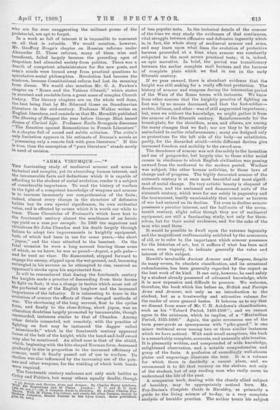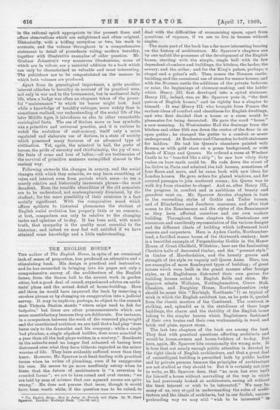" ARMA. VIRUMQUE —."*
TEE fascinating study of mediaeval armour and arms is technical and complex, yet its abounding human interest, and the innumerable facts and deductions which it is capable of affording to the student of social evolution, render it a subject of considerable importance. To read the history of warfare in the light of a competent knowledge of weapons and armour Is to increase immensely our comprehension of the facts ; indeed, almost every change in the structure of defensive Labile has its own special significance, its own evidential value, and is effected by causes which it is worth our while to trace. Those Chronicles of Froissart's which have lent to the fourteenth century almost the semblance of an heroic age yield us a case par exenaple. In 1369 the sagacious and chivalrous Sir John Chandos met his death largely through failure to adopt two improvements in knightly equipment, both of which had been in use for some yeam—the short
jupon," and the visor attached to the bascinet. On the fatal occasion he wore a long surcoat bearing those arms of which, as we know, he was so proud—Argent, a pile guise— and he used no visor. He dismounted, stepped forward to eagage the enemy, slipped upon the wet ground, and, becoming entangled in his surcoat as he attempted to rise, received an onponetit's stroke upon his unprotected face. It will be remembered that during the fourteenth century the knights made a practice of descending from their horses to fight on foot; it was a change in tactics which arose out of the perfected use of the English longbow and the increased Importance of the infantry. It is interesting to trace in the evolution of armour the effects of these changed methods of "Sr. The shortening of the long surcoat, first to the cyclaa form, and finally to the close-fitting, short jupon, was an alteration doubtless largely promoted by innumerable, though unrecorded, instances similar to that of Chandos. Among 'Other details connected, not remotely, with the practice of • gliting on foot may be instanced the dagger called misericorde," which in the fourteenth century appeared borne at the belt of the knight, while the hand-and-half sword may also be mentioned. An allied case is that of the shield, winch, beginning with the kite-shaped Norman form, decreased gradually in size in proportion to the increased efficiency of armour, until it finally passed out of use in warfare. Its decline was also influenced by the increasing ma of the pole- axe and other weapons, for the wielding of which both bands were required.
The fourteenth century embraces not only such battles as U1'6.cy and Poitiers, but many others equally deadly, though v*,til) British and Foreign Arms and Armour. By Charles Henry Ashdown. 11.44. 6180 Engravings and 49 Plates. London : T. C. and E. C. Jack. bailee • tat..1—(8) A Complete Guide to Heraldry. By Arthur Charles Fox. 1..voth 2,% Plates, 9 in Colour, and nearly 800 other Designs, unduly by Illeth.ilston, Herald Lunter to the Lyon Court. Same publishers. of less popular note. In the technical details of the armour of the time we may study the evidences of that continuous, vital struggle between offensive and defensive ingenuity which is, in fact, the whole story of mediaeval armour and arms, and may learn upon what lines the evolution of protective harness proceeded at a time when armour was constantly subjected to the most severe practical tests ; it is, indeed, an epic narrative. In brief, the period was transitionary between the earlier complete mail harness and the harness of complete plate which we find in use in the early fifteenth century.
If we pass onward, there is abundant evidence that the knight was still seeking for a really efficient protection. Time history of armour and weapons during the internecine period of the Wars of the Roses teems with instances. We know from other sources that the knightly practice of fighting on foot was by no means decreased, and that the foot-soldier- archer, billman, and other—was of still augmented importance ; but, were we without the knowledge, we might gather it from the armour of the fifteenth century. Reinforcements for the breast-plate, for the shoulders, arms, and elbows, are among the many changes that we find; nor are they to be entirely assimilated to earlier reinforcements ; many are designed only as protections for the left side of the body—as substitutes, partly, for the discarded shield—while different devices give increased freedom and mobility to the sword-arm.
The decadence of armour was not due solely to the invention and use of gunpowder, but largely also to those wider social causes in obedience to which English civilisation was passing onward from the mediaeval to the modern period. Warfare was subject, like other human activities, to those laws of change and of progress. The highly decorated armour of the sixteenth century is at once most beautiful and most signifi- cant of social change. Its very artistic beauty is eloquent of decadence, and the embossed and damascened suits of the sixteenth century, which were for use solely in pageantry and the tournament, testify unmistakably that armour as harness of war had entered on its decline. Yet even in decline armour possesses a peculiar interest, and the half-suits of the seven- teenth century, slight relics though they are of mediaeval equipment, are still a fascinating study, not only for them- selves, but for their social evidences, and for the sake of the men who used them.
It would be possible to dwell upon the extreme ingenuity and the magnificent craftsmanship exhibited by the armourera of old, or to refer to the importance which armour possesses for the historian of art; but it suffices if what has been said serves, even vaguely, to indicate generally the value and interest of thin subject.
Hewitt's invaluable Ancient Armour and TVeapons, despite its many errors, its obsolete classification, and its occasional redundancies, has been generally regarded by the expert as the best work of its kind. It can only, however, be used safely by a student already possessed of advanced knowledge, while it is now expensive and difficult to procure. We welcome, therefore, the book which lies before us, British and Foreign Arms and Armour, not only as an introduction to the student, but as a trustworthy and attractive volume for the reader of more general tastes. It behoves us to say that we dissent from some of Mr. C. H. Ashdown's classifications, such as his "Tabard Period, 1430.1500"; and we cannot agree to the existence, which he implies, of a "Maximilian Period, 1525-1600." Again, the quite erroneous use of the term passe-garde as synonymous with " pike-guard " is one minor technical error among two or three similar instances which we have noticed. With such small exceptions, the book is a remarkably complete, accurate, and unusually able treatise. It is pleasantly written, and compounded of wide knowledge, enlightened observation, and a notable comprehension and grasp of the facts. A profusion of exceedingly well-chosen plates and engraviugs illustrate the text. It is it volume for which there is decidedly a vacant place, . and we recommend it to fill that vacancy on the shelves, not only of the student, but of any reading man who really cares to understand the life of the past.
A companion work, dealing with the closely allied subject of heraldry, may be appropriately noticed here. Mr. Fox-Davies's Complete Guide to Heraldry, as primarily a guide to the living science of to-day, is a very complete analysis of heraldic practice. The author treats his subject in the rational spirit appropriate to the present time, and offers observations which are enlightened and often original. Historically, with a trifling exception or two, his work is accurate, and the volume throughout is a comprehensive. statement in detail of precedents ruling modern heraldry, together with illustrative examples of older practice. Mr. Graham Johnston's very numerous illustrations, some of which are in colour, are a material addition to a book which can only be characterised as valuable and most interesting. The publishers are to be congratulated on the manner in which both volumes are produced.
Apart from its genealogical importance, a quite peculiar interest attaches to heraldry on account of its practical uses, not only in war and in the tournament, but in mediaeval daily life, when a badge was often an eloquent token of the power- .ful " maintenance " to which its bearer might look. And while a knowledge of heraldry enlarges, more widely than is sometimes realised, our understanding of the social life of the later Middle Ages, it introduces us aiso to other remarkable sociological facts. The use of devices more or less symbolic was a primitive and universal practice, and it is curious to watch the , evolution of coat-armory, itself only a more regulated and elaborate use of devices, in a state of society., which possessed many features of an advanced type of civilisation. Yet, again, the minstrel in hall, the gestes of heroes, the pride of ancestry and chieftainship, the joy of war, the feats of arms and love of ladies,—all are testimonies of the survival of primitive manners exemplified almost in the ancient way.
Following onwards the changes in armory, and the social. changes with which they coincide, we may learn something of value and interest even from periods which seem—to use a merely relative and historically inaccurate phrase—the most decadent. Even the heraldic absurdities of the old armorists are to be understood, not contemptuously dismissed, by the student; for the mere possibility of their existence is a fact socially significant. With the comparative mood which affixes epithets to historical phenomena the student of English social evolution has properly little or no concern ; at best, comparison can only be relative to the changing tastes and opinions of to-day. It has been said, with much truth, that sympathy is the quality most essential to the historian; and indeed we may feel well satisfied if we have attained some knowledge and a little understanding.







































 Previous page
Previous page